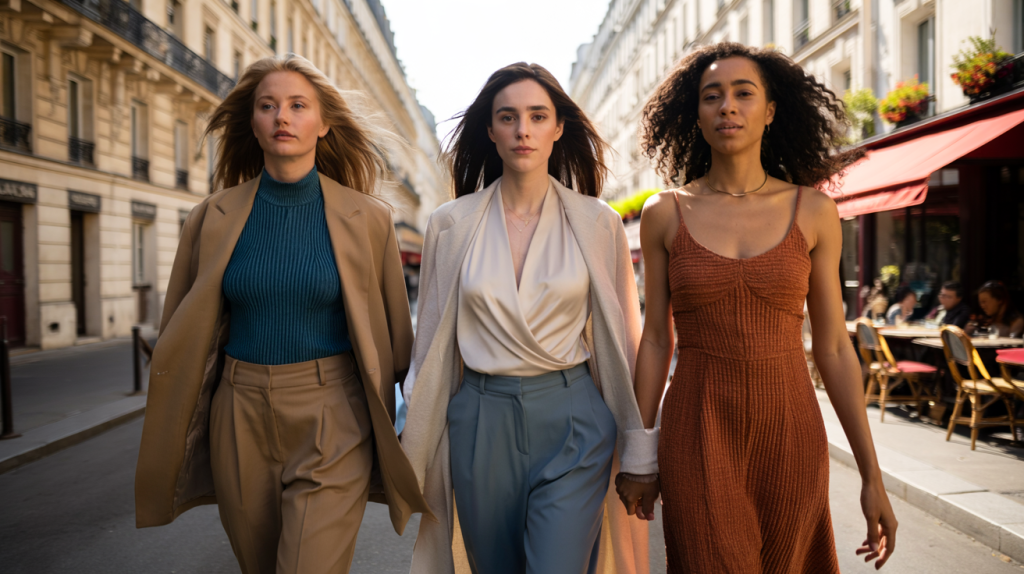Across French streets and offices, straps are vanishing and silhouettes are loosening. The braless shift is visible, talked about, and no longer just a summer whim. It taps into comfort, body autonomy, and changing dress codes, which explains why the topic lands so high in searches.
Context matters. France lived through a 55-day first lockdown, from 17 March to 11 May 2020, that reshaped habits at home and in public. Surveys then recorded a real switch in lingerie routines, especially among the youngest women, and the conversation has kept growing since (IFOP, 2020; IFOP, 2022).
Braless in France: the trend, the numbers, the rules
The first wave of data came early. An IFOP survey in June 2020 observed that a notable share of French women reported wearing bras less often during lockdown, with under-25s showing the sharpest change (IFOP, 2020). A follow-up in 2022 highlighted that young women were the most likely to have gone braless outside the home at least once in the past 12 months (IFOP, 2022).
What about the law in France. There is no legal requirement to wear a bra in public spaces. In the workplace, employers may set clothing rules when they are justified by safety, hygiene, or the company’s image, and when they remain proportionate. That means a blanket obligation to wear a bra would be hard to defend without a concrete reason in a specific role (Code du travail, jurisprudence).
Health claims often circulate. A small, preliminary French study led by Jean-Denis Rouillon tracked about 300 women over nearly 15 years and questioned the idea that bras prevent sagging, while stressing limits to generalization (Université de Franche-Comté, 2013). Medical bodies still call for individualized comfort and support, especially for sport.
Comfort, health, style: what actually changes without a bra
Comfort leads the pack. Many women describe less pressure on the ribcage and shoulders when underwires and tight bands disappear. Softer fabrics and seamless cuts also reduce chafing in heat.
Support depends on activity. For daily walking or desk work, some busts feel fine with no structure at all. For running or jumping, movement multiplies and tissues need targeted support. Sports medicine recommends minimizing vertical bounce to reduce pain and soft tissue strain.
Visibility is the practical question. Nipples can show through thin tops or under bright lighting. Some welcome it, others prefer to mute it. Fabric weight, texture, and color make a bigger difference than many expect.
Style adjusts quickly. Structured jackets, heavier knits, or draped blouses create a smooth line. Stretch tops with double layers help. So do dresses with built-in lining or shelf panels that accomodate the chest without compression.
Everyday situations: street, work, gym
On the street, the rule is simple. Public decency laws in France do not target bras; going braless is allowed the same way a T-shirt or a knit top is allowed. Context and setting shape social reactions, not a legal ban.
At work, clarity helps. A customer-facing role may involve a dress code, but it must be justified and proportionate. Many dress policies focus on neatness, transparency of fabrics, and overall silhouette rather than specifying underwear. HR guidance and internal rules matter more than personal opinions.
For sport, function wins. High-impact activities call for bounce control to avoid pain. Low-impact sessions like yoga or Pilates allow for bralettes, compressive tops, or no bra if comfort remains. Pain is a cue to adjust support or technique.
For events, fabric is strategy. Bias-cut dresses, thick crepe, or textured knits reduce outlines. Adhesive cups or silicone covers can add a degree of discretion without the feel of a full bra.
Practical guide: how to go braless with confidence
Small changes improve comfort and ease, indoors or outside. The following checklist covers the basics without overbuying.
- Choose thicker or textured fabrics (ribbed cotton, crepe, boucle) to soften outlines.
- Prefer darker or saturated colors under bright light; double layers help in white.
- Size the armhole and neckline so the chest sits comfortably without edge pressure.
- Use soft liners or disposable nipple covers when needed; test them for sensitivity.
- For work, pair unlined tops with a structured blazer or cardigan to smooth the profile.
- For movement, try compressive tanks or built-in shelf tops; upgrade to a sports bra for high impact.
- Maintain skin comfort with breathable fibers and gentle, fragrance-free care if rubbing appears.
One last piece remains: fit experimentation. Two or three try-ons with different fabrics and cuts typically settle the right balance between ease, support, and the silhouette wanted. The braless route is not all or nothing; it can be situational, day by day, and that flexibility is exactly what keeps the trend durable in France.
